Table of Contents
Welcome to Composting 101! If you’re new to composting, this beginner’s guide is the perfect place to start. Composting is a simple and eco-friendly way to transform organic waste into nutrient-rich soil. By following a few easy steps, you can create your own compost and make a positive impact on the environment.
Composting involves combining organic matter like food scraps, leaves, grass clippings, and coffee grounds, along with water, oxygen, and beneficial organisms. This mixture breaks down over time, resulting in compost that nourishes your plants and reduces landfill waste. Whether you have a green thumb or are just beginning your gardening journey, composting is a valuable skill to cultivate.
Throughout this guide, we’ll cover everything you need to know about composting for beginners. From understanding the benefits of composting to choosing the right composting method, setting up your compost pile or bin, and troubleshooting common issues, we’ve got you covered. By the end of this guide, you’ll be well-equipped to start your own composting journey and witness the transformative power of turning waste into valuable soil.
Key Takeaways:
- Composting is an eco-friendly way to transform organic waste into nutrient-rich soil.
- By composting, you can reduce landfill waste and the production of greenhouse gases.
- Compost improves soil health, conserves water, and promotes biodiversity.
- There are various composting methods to choose from, depending on your space and preferences.
- Proper maintenance, such as turning the compost pile and monitoring moisture levels, is essential for successful composting.
Benefits of Composting
Composting offers a multitude of benefits, making it a worthwhile practice for both individuals and the environment. By diverting organic materials from landfills, composting significantly reduces waste and helps combat climate change. Landfills are a major source of methane, a potent greenhouse gas that contributes to global warming. By composting organic waste, we can minimize methane emissions and make a positive impact on the planet.
Aside from its environmental benefits, composting also improves soil health and fertility. Compost is a valuable source of nutrients for plants, providing essential elements like nitrogen, phosphorus, and potassium. It enhances the soil’s structure, water-holding capacity, and nutrient availability, promoting healthier and more productive gardens. By incorporating compost into your soil, you can minimize the use of chemical fertilizers and create a sustainable and natural growing environment.
Furthermore, composting helps to conserve water in agricultural systems. The organic matter in compost aids in retaining moisture in the soil, reducing the need for frequent irrigation. This is particularly beneficial in regions with limited water resources or during dry spells. By using compost as a soil amendment, you’ll not only nourish your plants but also contribute to water conservation efforts.
| Benefits of Composting | |
|---|---|
| Reduces waste and landfill space | ✓ |
| Helps combat climate change | ✓ |
| Improves soil health and fertility | ✓ |
| Reduces the need for chemical fertilizers | ✓ |
| Conserves water in agricultural systems | ✓ |
“Composting not only benefits the environment but also improves the quality of our gardens. It’s a win-win situation for both nature and our plants.” – Gardening enthusiast
Reasons to Compost
There are several compelling reasons to start composting. Firstly, composting allows you to minimize food waste. Instead of throwing away leftover fruits, vegetables, and other organic materials, you can divert them towards creating nutrient-rich compost. This not only helps you reduce your environmental footprint but also makes you more conscious about your consumption habits.
Composting also offers a cost-effective alternative to chemical fertilizers. By producing your own compost, you can save money on store-bought fertilizers while still nourishing your plants with essential nutrients. Plus, composting is relatively easy and requires minimal resources, making it an accessible and affordable option for gardeners of all levels of experience.
Lastly, composting allows you to actively participate in the natural cycle of life. Instead of sending organic waste to landfills where it rots and produces harmful gases, you can return these materials back to the earth. Composting embodies the principle of sustainability and reminds us of the interconnectedness between humans and the environment.
- Minimizes food waste
- Cost-effective alternative to chemical fertilizers
- Contributes to the natural cycle of life
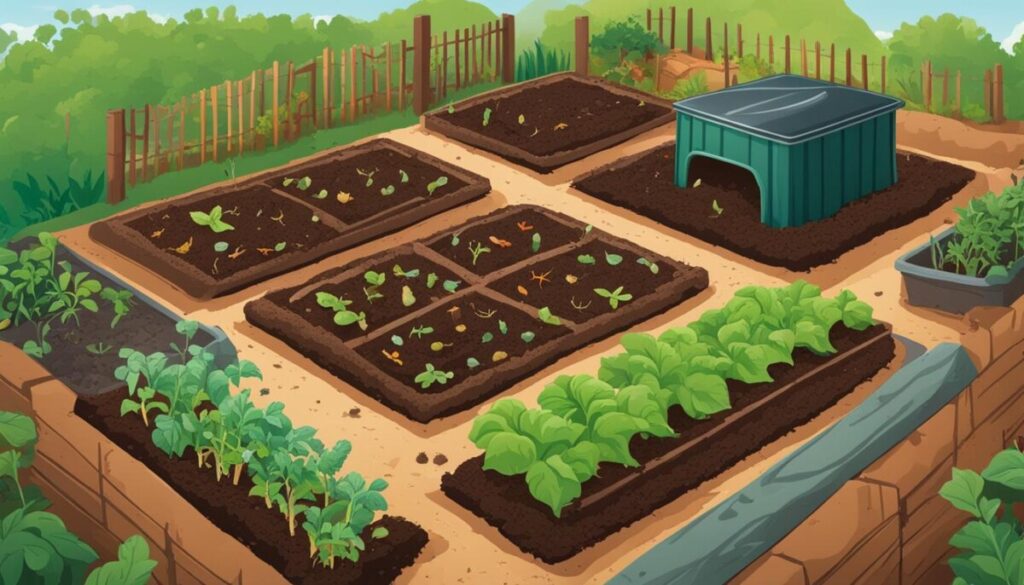
Understanding the Basics of Composting
Composting is an organic process that harnesses the power of decomposition to create nutrient-rich soil. By understanding the basics of composting, you can create a successful compost pile that will benefit your garden and the environment.
Composting requires a mixture of “brown” and “green” materials. Browns, such as dry leaves and sawdust, provide carbon, while greens, like food scraps and fresh grass clippings, provide nitrogen. The ideal ratio is approximately 30 parts carbon to 1 part nitrogen. These materials should be layered and mixed together to create a balanced compost pile.
In addition to the right mix of materials, composting also requires air and moisture. Turning the compost pile periodically helps aerate the materials and speed up decomposition. It’s important to maintain the moisture level by adding water if the pile is too dry or mixing in dry materials if it’s too wet.
With these basic principles in mind, you can create a compost pile that will break down organic matter and produce nutrient-rich soil that can be used to nourish your plants and reduce waste.
Composting Basics Table
| Materials | Carbon Content | Nitrogen Content |
|---|---|---|
| Dry leaves | High | Low |
| Sawdust | High | Low |
| Food scraps | Low | High |
| Fresh grass clippings | Low | High |
Choosing the Right Composting Method
When it comes to composting, there are several methods to choose from. The key is to select a method that suits your space, time, and preferences. Let’s explore some beginner-friendly composting methods:
Traditional Backyard Bins
Traditional backyard bins are a popular choice for many composters. These bins allow for the natural ecosystem to interact with the compost pile, promoting microbial activity and decomposition. They are typically made from materials like wood or plastic and come in various sizes. With a traditional backyard bin, you can easily add and mix your compost materials while providing proper airflow and drainage.
Tumblers
Tumblers are another option for beginner composters. These bins provide a more contained system that is easier to manage. They are often designed with a rotating mechanism, allowing you to easily turn the compost and speed up the decomposition process. Tumblers also help deter pests and rodents, making them a convenient choice for those who want a hassle-free composting experience.
Vermicomposting
Vermicomposting, also known as worm composting, is an ideal method for beginners with limited outdoor space or those who want a quicker composting process. This method involves using worms to decompose organic waste. A vermicomposting bin typically contains bedding materials, such as shredded newspaper or coconut coir, along with worms that consume the waste and produce nutrient-rich castings. It’s a fascinating and efficient way to recycle kitchen scraps and create valuable compost.
| Composting Method | Pros | Cons |
|---|---|---|
| Traditional Backyard Bins | Allows for natural ecosystem interaction, promotes microbial activity, customizable size options | May require more space, slower decomposition compared to other methods |
| Tumblers | Easier to manage, faster decomposition, deters pests and rodents | More expensive than traditional bins, limited capacity |
| Vermicomposting | Space-efficient, quick composting process, ideal for indoor or limited outdoor space | Requires proper management of worm bin, specific conditions for worms’ well-being |
Consider your available space, time commitment, and desired outcomes when choosing a composting method. Remember, no matter which method you choose, the key is to provide the right balance of organic matter, air, moisture, and microbial activity to create nutrient-rich compost for your garden.
Setting Up Your Compost Pile or Bin
Setting up your compost pile or bin is an important step in the composting process. Choosing the right location, creating the right layers, and maintaining proper aeration and moisture are key factors for successful composting. Here are some guidelines to help you set up your compost pile or bin:
Choosing the Location
When selecting a location for your compost pile or bin, consider accessibility and drainage. Choose a spot that is easily reachable for adding materials and turning the pile. Ensure that the area has good drainage to prevent excess moisture accumulation, which can lead to odor and decomposition problems.
Creating the Layers
Start by creating a base layer of “brown” materials, such as dry leaves or straw. This layer provides carbon and helps with airflow in the pile. Then, add a layer of “green” materials, such as food scraps or fresh grass clippings, which provide nitrogen. Alternate between brown and green layers to maintain a balanced carbon-to-nitrogen ratio. Repeat this layering process until you reach the desired height for your compost pile or bin.
Maintaining Aeration and Moisture
Adequate aeration and moisture are essential for the decomposition of organic matter. Turn the compost pile or mix the materials in the bin regularly to ensure proper airflow and prevent the pile from becoming compacted. Moisture levels should be similar to that of a damp sponge. If the pile is too dry, add water. If it’s too wet, mix in dry materials like leaves or shredded paper.
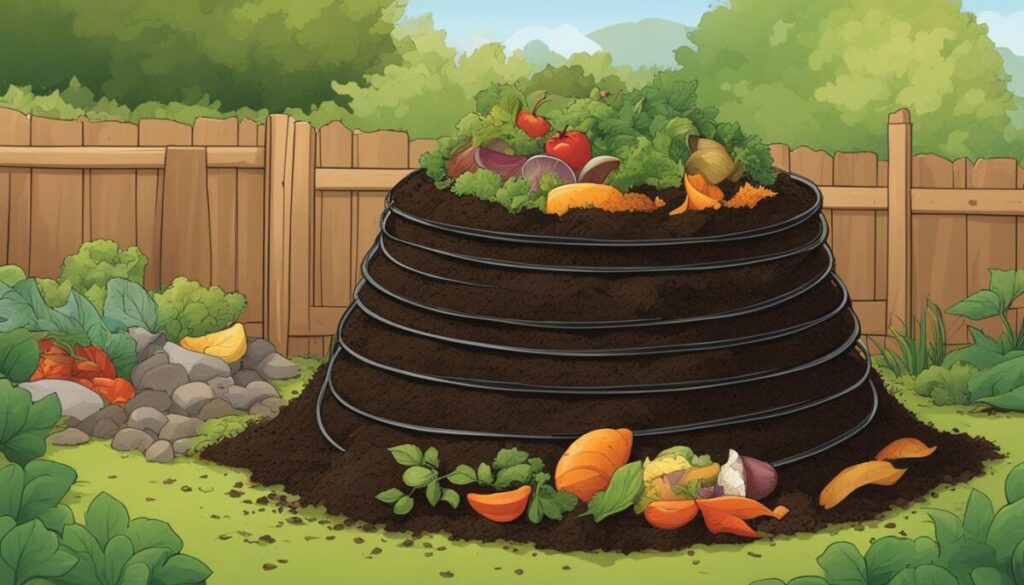
| Materials to Include | Materials to Avoid |
|---|---|
|
|
Remember, a well-set-up compost pile or bin will create the ideal conditions for organic waste to decompose into nutrient-rich compost. By following these guidelines, you’ll be on your way to producing high-quality compost to nourish your garden and reduce organic waste.
What to Compost and What Not to Compost
Composting is a fantastic way to reduce waste and create nutrient-rich soil for your garden. But knowing what can and cannot be composted is essential for maintaining a healthy composting process. Here’s a breakdown of what you should and shouldn’t compost:
Compostable Materials
There is a wide range of compostable materials that can go into your compost pile. These include:
- Fruit and vegetable scraps
- Coffee grounds and filters
- Tea bags (make sure they are made of paper and not plastic)
- Eggshells
- Grass clippings
- Leaves
- Straw
- Garden waste (such as plant trimmings and weeds without seeds)
- Shredded newspaper or cardboard
What Not to Compost
While many organic materials can be composted, there are some things you should avoid adding to your compost pile. These include:
- Meat, fish, and bones (these can attract pests and take longer to break down)
- Dairy products (they can create odor and attract unwanted animals)
- Oily foods (they can disrupt the composting process)
- Grease and fat (these can also slow down the decomposition process)
- Coal ashes or charcoal (they can contain harmful substances)
- Yard waste treated with pesticides or herbicides (these chemicals can harm beneficial organisms in your compost)
- Weeds with mature seeds or diseased plants (they can spread weeds or diseases to your garden)
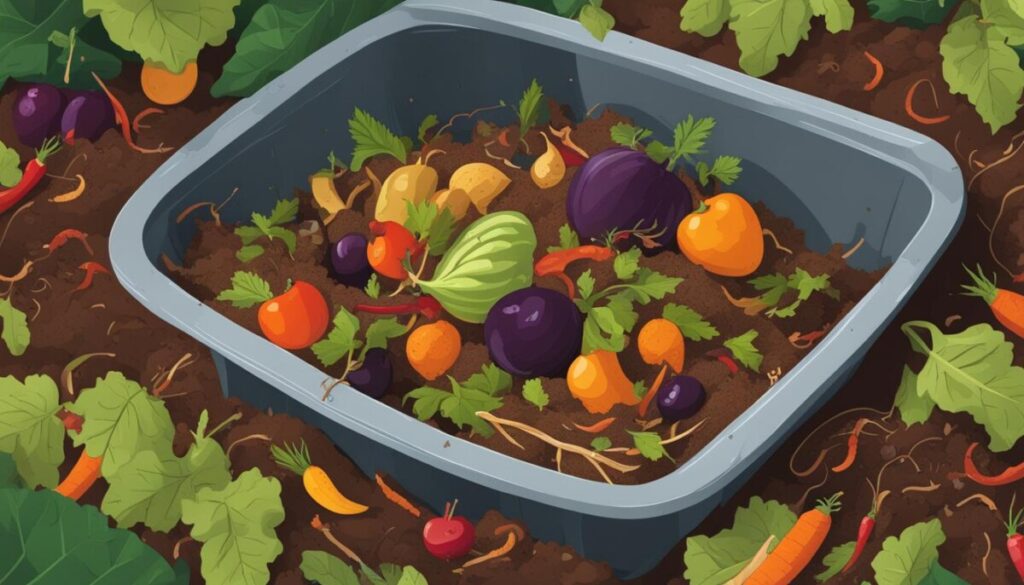
By being mindful of what you add to your compost pile, you can ensure that you’re creating a healthy and productive environment for decomposition. Remember to maintain a balance between carbon-rich “browns” and nitrogen-rich “greens,” turn your compost regularly, and keep it moist but not overly wet. With the right mix of ingredients and proper care, your compost pile will transform waste into valuable soil amendment for your garden.
Maintaining Your Compost Pile or Bin
Proper maintenance is essential for the success of your composting endeavor. By regularly turning your compost pile or bin, you can ensure adequate aeration and speed up the decomposition process. Aim to turn the pile every 2-4 weeks or whenever the temperature drops below the necessary range of 90-150 degrees Fahrenheit. Adjust the moisture level as needed by adding water if the pile is too dry or mixing in dry materials if it’s too wet. Keeping a close eye on the carbon-to-nitrogen ratio and maintaining a balance of greens and browns in your compost will contribute to optimal composting results.
One effective way to turn your compost pile is by using a pitchfork or a compost aerator tool. Simply insert the tool into the pile and lift and turn the materials. This helps introduce oxygen to the pile and promotes the breakdown of organic matter. It’s also important to ensure that your compost receives adequate moisture. The materials should be damp, like a wrung-out sponge, without being overly wet.
| Maintenance Tips for Composting |
|---|
| Regularly turn the compost pile or bin to promote aeration and decomposition. |
| Monitor and adjust the moisture level to keep the compost damp but not overly wet. |
| Check the carbon-to-nitrogen ratio and maintain a balance of greens and browns for optimal composting. |
| Use a pitchfork or compost aerator tool to turn the pile and introduce oxygen. |
| Cover the compost to retain moisture and prevent it from drying out or getting too wet during heavy rainfall. |
| Monitor temperature and adjust the pile if it’s too hot or too cool to support decomposition. |
Another key aspect of maintaining your compost pile is covering it. A covering such as a tarp or a compost bin lid helps retain moisture and prevent the pile from drying out or getting too wet during heavy rainfall. In addition, it helps regulate temperature by insulating the pile and protecting it from extreme heat or cold.
“Regularly turning your compost pile ensures that all the organic matter gets exposed to oxygen, which speeds up the decomposition process.” – Gardening expert
By following these maintenance tips, you can create a thriving composting system that produces rich, nutrient-dense compost for your garden. Remember to be patient and give the composting process time to work its magic. With consistent effort and attention to maintenance, you’ll be rewarded with a bountiful supply of compost to nourish your plants and contribute to a more sustainable lifestyle.
Harvesting and Using Your Finished Compost
Once your compost has gone through the decomposition process and transformed into dark, crumbly soil, it’s time to harvest and put it to use in your garden. Harvesting your finished compost is a simple process that involves sifting out any remaining large materials. This ensures that you are left with a fine, nutrient-rich soil that is ready to be used.
To harvest your compost, you can use a garden sieve or a compost sifter. These tools allow you to separate the fully decomposed compost from any unfinished materials. Simply place a container underneath the sieve or sifter and gently shake it back and forth. The fine compost will fall through while the larger pieces remain on top.
| Ways to Use Your Finished Compost |
|---|
| 1. Amend garden soil: Mix the finished compost into your garden soil to enrich it with nutrients and improve its structure. This will help your plants thrive and promote healthy growth. |
| 2. Enrich potting mixes: Add the compost to your potting mixes to provide your potted plants with the necessary nutrients. It will help retain moisture and improve the overall health of your plants. |
| 3. Topdress lawns: Sprinkle a thin layer of finished compost on your lawn to improve its health and fertility. This will help your grass grow thicker and greener. |
| 4. Create compost tea: Steep a portion of your compost in water to create compost tea. This nutrient-rich liquid can be used as a natural fertilizer for your plants. |
Using finished compost in your garden is like giving your plants a nutritious meal. It provides them with the essential nutrients they need to grow and thrive. Plus, it’s a sustainable way to recycle organic waste and reduce your environmental footprint.
Remember to allow your finished compost to cure for at least four weeks before using it in your garden. This allows any remaining pathogens or toxins to break down, ensuring that your plants are not harmed. Once cured, your compost is ready to nourish your plants and contribute to a healthy and vibrant garden ecosystem.
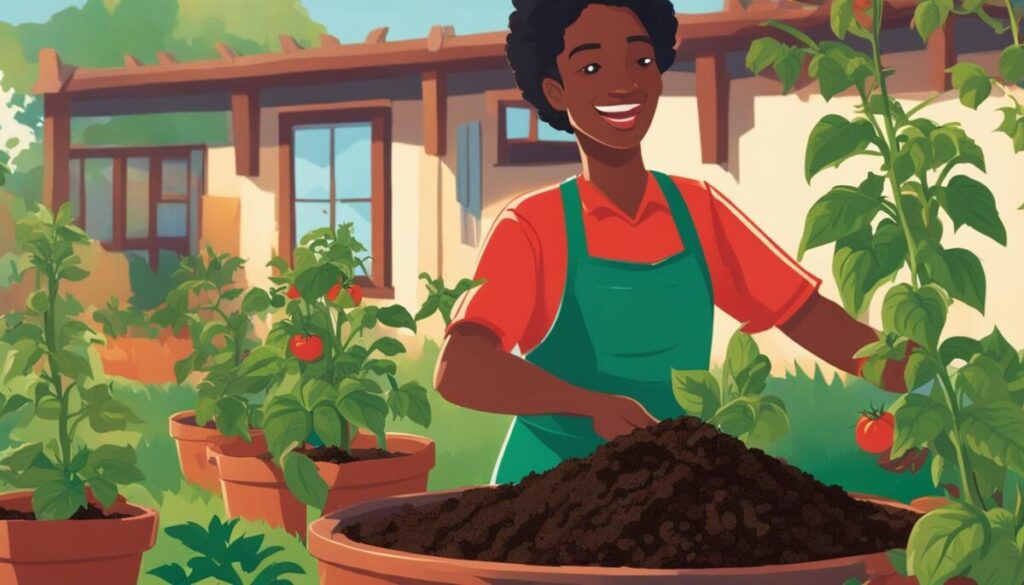
Troubleshooting Common Composting Issues
Composting is a rewarding process, but it can sometimes come with challenges. Here are some common composting issues and tips to troubleshoot them:
Compost Pile Odor
If your compost pile emits a foul smell, it may be a sign of excess moisture or lack of airflow. To mitigate this issue, turn the compost pile to increase aeration and add dry materials such as straw or shredded newspaper to absorb excess moisture. Additionally, ensure that you’re maintaining the right balance of browns (carbon-rich materials) and greens (nitrogen-rich materials) in your compost pile.
Compost Not Heating Up
If your compost pile is not generating enough heat or decomposing properly, it may lack sufficient nitrogen-rich greens. Add more green materials, such as vegetable scraps or grass clippings, to increase the nitrogen content. Turning the pile regularly will also help distribute heat and promote decomposition. It’s essential to maintain the right carbon-to-nitrogen ratio and provide proper moisture levels to facilitate the composting process.
Pests in Your Compost Pile
Fruit flies and rodents can sometimes be attracted to compost piles that contain food scraps. To deter pests, bury food scraps deep within the compost pile, and avoid adding large amounts of fruit or sugary materials. Consider using an animal-resistant compost bin or covering your compost pile with a tarp to prevent access. It’s important to maintain a proper composting environment while keeping unwanted pests at bay.
By troubleshooting these common composting issues, you can overcome challenges and continue on your composting journey with confidence. Remember to monitor your compost pile regularly, make adjustments as needed, and enjoy the benefits of nutrient-rich compost for your plants and garden.
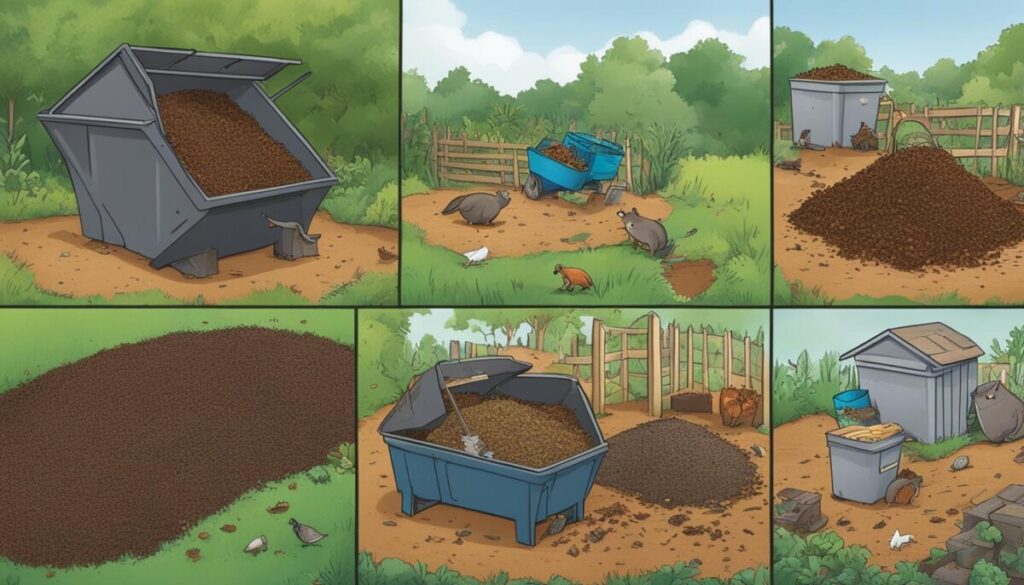
| Composting Issue | Troubleshooting Tips |
|---|---|
| Compost Pile Odor | – Turn the compost pile for better aeration – Add dry materials to absorb excess moisture – Ensure a proper balance of browns and greens |
| Compost Not Heating Up | – Add more nitrogen-rich greens – Turn the pile regularly to distribute heat – Monitor carbon-to-nitrogen ratio and moisture levels |
| Pests in Your Compost Pile | – Bury food scraps deep within the pile – Avoid adding large amounts of fruit or sugary materials – Consider using an animal-resistant compost bin or tarp |
Indoor Composting for Beginners
Indoor composting provides a convenient solution for those who don’t have access to outdoor space or live in apartments. With the right methods, you can still contribute to the composting process and reduce waste. There are several indoor composting options to consider:
- Vermicomposting: This method involves using worms to break down organic waste. A worm bin is used to create a controlled environment where the worms feed on kitchen scraps, producing nutrient-rich compost.
- Bokashi composting: Bokashi is a Japanese term for fermenting organic waste. In this method, beneficial microorganisms are added to a container filled with food scraps. The microorganisms break down the waste, resulting in a nutrient-rich liquid that can be used as a soil amendment.
- Compost tumblers: These compact units provide a contained system for composting. They often have mechanisms to aid in the aeration and decomposition of the organic materials. This method is suitable for those who have limited space and want a hassle-free composting process.
When practicing indoor composting, it’s important to monitor moisture levels and ensure proper aeration. Avoid adding meat, dairy, oily foods, and yard waste treated with pesticides or herbicides to your indoor compost. By following these tips and choosing the right method for your situation, you can successfully compost indoors and contribute to a more sustainable lifestyle.
Benefits of Indoor Composting
Indoor composting offers several advantages. It allows you to conveniently recycle kitchen scraps and reduce waste, even in small living spaces. By composting indoors, you can also minimize odors and pests commonly associated with outdoor composting. Additionally, the resulting compost can be used to enrich your houseplants or shared with friends who have outdoor gardens.
Although indoor composting may require a bit more attention and maintenance compared to outdoor methods, the benefits make it worth considering. It allows you to actively participate in composting, regardless of your living situation, and play a part in creating a more sustainable future.
| Indoor Composting Methods | Pros | Cons |
|---|---|---|
| Vermicomposting | Produces nutrient-rich compost. Suitable for small spaces. Can be done year-round. | Requires purchasing or setting up a worm bin. Requires regular maintenance and monitoring of moisture levels. |
| Bokashi Composting | Can handle a wide variety of organic waste. Fermentation process helps reduce odors. | Requires airtight containers and the use of microorganisms. Liquid byproduct needs proper disposal. |
| Compost Tumblers | Compact and convenient. Provides a controlled environment for composting. | May require an initial investment. Limited capacity compared to larger outdoor compost systems. |
Choose the indoor composting method that suits your needs and space availability. Remember to follow the specific guidelines for each method to ensure successful composting indoors.
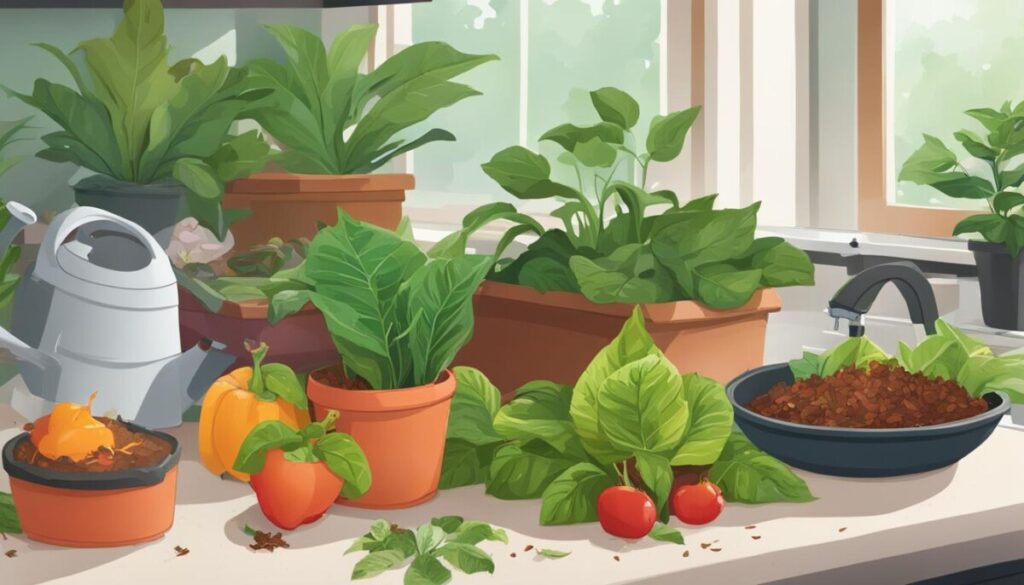
Tips for Successful Composting
Composting is a rewarding and sustainable practice that can benefit both your garden and the environment. To help you achieve successful composting, here are some essential tips and techniques to keep in mind:
Balancing Greens and Browns
When composting, it’s important to maintain a proper balance between “green” and “brown” materials. Greens, such as fruit and vegetable scraps, provide nitrogen, while browns, such as dry leaves and sawdust, provide carbon. Aim for a ratio of approximately 30 parts carbon to 1 part nitrogen to create an ideal composting environment.
Proper Moisture and Aeration
Compost needs the right amount of moisture and airflow to decompose effectively. Keep your compost pile or bin moist, but not overly wet or dry. If it becomes too dry, add water, and if it becomes too wet, mix in dry materials like leaves or straw. It’s also essential to turn the compost occasionally to provide oxygen and ensure proper aeration.
Chop or Shred Organic Materials
To speed up the composting process, consider chopping or shredding larger organic materials into smaller pieces. This will increase the surface area, allowing for quicker decomposition. Smaller particles also help to create a more homogeneous compost mixture, promoting efficient breakdown of materials.
| Tips for Successful Composting |
|---|
| Balance greens and browns |
| Maintain proper moisture and aeration |
| Chop or shred organic materials |
By following these tips and techniques, you’ll be on your way to successful composting. Remember to monitor your compost pile’s moisture, turn it regularly for adequate airflow, and achieve a balanced mix of greens and browns. With time and patience, you’ll create nutrient-rich compost that will nourish your plants and contribute to a healthier environment.
Composting Troubleshooting: Frequently Asked Questions
Composting can sometimes raise questions and present challenges for beginners. Below, we address some of the most common questions and provide answers to help troubleshoot specific issues you may encounter along your composting journey.
How long does it take to compost?
The time it takes to compost can vary depending on factors such as the composting method, ingredients used, and environmental conditions. Generally, it takes anywhere from a few months to a year for organic materials to fully decompose into nutrient-rich compost. Regular turning of the pile, proper moisture levels, and the right carbon-to-nitrogen ratio can help speed up the process.
What should I do with moldy fruits or vegetables?
If you come across moldy fruits or vegetables in your compost pile, it’s best to remove them. While some molds are beneficial for the decomposition process, others may produce spores that can spread disease or hinder the composting process. To prevent the spread of mold, discard any moldy organic matter in the trash or bury it deeply in the compost pile.
Can I use a composting tumbler?
A composting tumbler is a container that allows for easy turning and mixing of compost materials. It provides a convenient way to aerate the compost and speed up the decomposition process. Composting tumblers are especially useful for those with limited space or who prefer a contained system. However, it’s important to monitor moisture levels and maintain the proper carbon-to-nitrogen ratio, just as you would with any other composting method.
By addressing these frequently asked questions, you can overcome common composting challenges and ensure a successful composting experience. Continue reading for more valuable information on composting in the following sections.
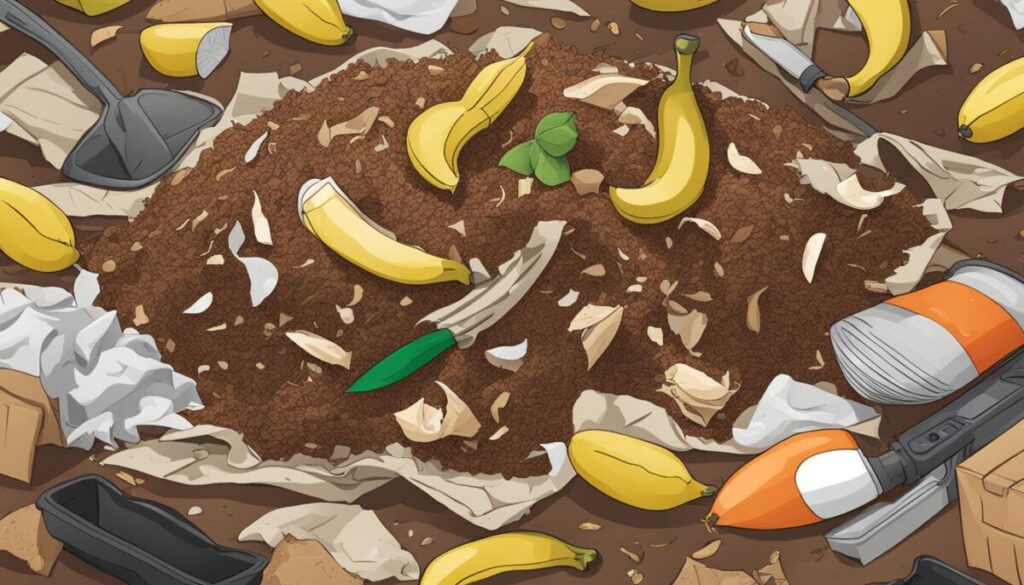
The Environmental Impact of Composting
Composting is not just a simple way to transform organic waste into nutrient-rich soil; it also has a profound impact on the environment. By diverting organic materials from landfills, composting helps reduce the production of methane, a potent greenhouse gas. According to the EPA, organic waste in landfills is one of the largest sources of methane emissions in the United States. By composting, you can significantly contribute to reducing greenhouse gas emissions and mitigating climate change.
Furthermore, composting improves soil health and contributes to sustainable agriculture. The nutrient-rich compost enriches the soil, enhancing its fertility and promoting the growth of healthy plants. Compost also improves water retention in the soil, reducing the need for irrigation and conserving water resources. By using compost instead of chemical fertilizers, you can avoid the negative environmental impacts associated with synthetic fertilizers, such as water pollution and soil degradation.
Composting also plays a vital role in promoting biodiversity and supporting a healthy ecosystem. The beneficial microorganisms present in compost help break down organic matter, releasing essential nutrients that support the growth of plants. This, in turn, attracts beneficial insects and promotes a diverse range of plant and animal species. By composting, you are creating a sustainable cycle of organic matter, nourishing the soil, and fostering a thriving environment for all living organisms.
| Environmental Impacts of Composting | |
|---|---|
| Reduces greenhouse gas emissions | Composting diverts organic waste from landfills, reducing methane emissions. |
| Improves soil health | Compost enriches soil, enhances fertility, and promotes water retention. |
| Conserves water resources | Compost reduces the need for irrigation, conserving water in agricultural systems. |
| Supports biodiversity | Composting fosters a healthy ecosystem and attracts beneficial insects and species. |
Overall, composting is a powerful tool for environmental sustainability. By reducing waste, conserving resources, and promoting a healthy ecosystem, composting empowers individuals to make a positive impact on the planet. Whether you have a small backyard or live in an apartment, there are composting methods suitable for every situation. Start composting today and contribute to building a greener and more sustainable future for generations to come.
Conclusion
Composting is a valuable practice that benefits both your garden and the environment. By following the tips and techniques outlined in this beginner’s guide, you can embark on your composting journey with confidence. Remember the importance of balancing greens and browns, maintaining proper moisture and aeration, and harvesting your finished compost. With time and practice, you’ll become a composting pro, contributing to a more sustainable and thriving garden ecosystem.
Composting is not only a way to reduce waste and create nutrient-rich soil, but it also helps mitigate climate change by reducing greenhouse gas emissions. Additionally, composting conserves water, promotes soil health, and contributes to biodiversity. By participating in composting, you play an active role in building a greener and more sustainable future.
So, why wait? Start composting today and witness the transformative power of turning kitchen scraps into garden gold. Whether you have a small backyard or live in an apartment, there are composting methods suitable for your needs. Embrace composting as a rewarding and eco-friendly practice that will benefit both you and the planet.
FAQ
How long does composting take?
The length of time it takes to compost can vary depending on factors such as the ingredients used, the size of the compost pile, and the maintenance level. Generally, it takes about 2 to 6 months for compost to fully decompose.
What should I do with moldy fruits?
Moldy fruits can be added to the compost pile, as long as they are not severely moldy or rotten. The composting process will help break down the mold and turn it into nutrient-rich soil.
What is a composting tumbler?
A composting tumbler is a container that is designed to make composting more convenient. It has a rotating mechanism that allows you to easily turn the compost, helping to aerate the materials and speed up the decomposition process.
Can I compost meat, bones, and dairy products?
It is generally not recommended to compost meat, bones, and dairy products. These materials can attract pests and may not decompose properly in a home composting system. It’s better to avoid adding them to your compost pile.
Can I compost yard waste treated with pesticides or herbicides?
Yard waste that has been treated with pesticides or herbicides should be avoided in composting. These chemicals can persist in the compost and may harm the beneficial organisms and plants in your garden.
How often should I turn my compost pile?
Aim to turn your compost pile every 2 to 4 weeks. Turning the pile helps mix the materials, aerate the pile, and speed up the decomposition process.
How do I know if my compost pile is too wet or too dry?
A compost pile that is too wet will be soggy and have a foul odor. On the other hand, a compost pile that is too dry will not decompose properly. The ideal moisture level is similar to that of a damp sponge. Adjust the moisture by adding water if it’s too dry or mixing in dry materials if it’s too wet.
When can I start using my finished compost?
It’s best to allow your finished compost to cure for at least four weeks before using it in your garden. This curing process will help stabilize the nutrients and ensure optimal results for your plants.
How can I deter pests from my compost pile?
To deter pests like fruit flies or rodents, bury food scraps deep within the compost pile or use an animal-resistant compost bin. This will help prevent pests from accessing the compost and causing disturbances.
Can I compost indoors?
Yes, you can compost indoors using methods such as vermicomposting, Bokashi composting, or compost tumblers. These indoor composting methods are suitable for limited spaces like apartments and offer convenient ways to compost without a traditional outdoor compost pile.
What are some tips for successful composting?
Some tips for successful composting include shredding organic materials into smaller pieces, layering materials for the optimal carbon-to-nitrogen ratio, avoiding compacting the compost, maintaining the right moisture level, monitoring temperature, and avoiding weeds or diseased plants in the compost pile.
What are some common composting problems and how can I troubleshoot them?
Common composting problems include bad odors, lack of heating or decomposition, and pest infestations. These issues can often be resolved by adjusting the moisture level, turning the compost pile more frequently, adding the right mix of greens and browns, or using pest deterrent methods.
What is the environmental impact of composting?
Composting plays a significant role in environmental sustainability. It helps reduce waste, lower greenhouse gas emissions, improve soil health, conserve water, and promote biodiversity. Community composting initiatives and municipal composting programs further contribute to a circular economy and a greener future.

Pingback: Worm Composting in Winter: Tips for Keeping Your Worms Warm and Productive - Wiggle And Waste
Pingback: Best Worms for Composting: A Guide to Choosing the Right Type - Wiggle And Waste
Pingback: European Night Crawler: A Guide to the Popular Vermicomposting Worm - Wiggle And Waste
It’s an amazing article in favor of all the online visitors;
they will take benefit from it I am sure.
My web page: vpn special code
Hi there! Do you know if they make any plugins to safeguard against hackers?
I’m kinda paranoid about losing everything I’ve worked hard on. Any tips?
My webpage … vpn special
I want to to thank you for this wonderful read!!
I absolutely enjoyed every bit of it. I’ve got you book-marked to look at new
stuff you post…
My blog post vpn code 2024
I’ve been exploring for a bit for any high quality articles or weblog posts on this sort of area .
Exploring in Yahoo I eventually stumbled upon this
web site. Studying this info So i am satisfied to exhibit that I have a very excellent uncanny feeling I found out just what I needed.
I most surely will make certain to do not put out of your mind this web site and provides it
a glance on a continuing basis.
Visit my website vpn special
Hey there are using WordPress for your blog platform?
I’m new to the blog world but I’m trying to get started and set up my own.
Do you require any coding expertise to make your own blog?
Any help would be greatly appreciated!
My web site :: vpn special coupon code 2024
Have you ever thought about writing an ebook or guest authoring on other
sites? I have a blog based upon on the same ideas you discuss and would love facebook vs eharmony to find love online have you share some stories/information. I know
my audience would appreciate your work. If you’re even remotely interested, feel free to send me an email.